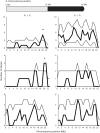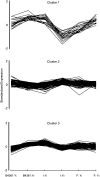Y not a dead end: epistatic interactions between Y-linked regulatory polymorphisms and genetic background affect global gene expression in Drosophila melanogaster
- PMID: 20551438
- PMCID: PMC2940279
- DOI: 10.1534/genetics.110.118109
Y not a dead end: epistatic interactions between Y-linked regulatory polymorphisms and genetic background affect global gene expression in Drosophila melanogaster
Abstract
The Y chromosome, inherited without meiotic recombination from father to son, carries relatively few genes in most species. This is consistent with predictions from evolutionary theory that nonrecombining chromosomes lack variation and degenerate rapidly. However, recent work has suggested a dynamic role for the Y chromosome in gene regulation, a finding with important implications for spermatogenesis and male fitness. We studied Y chromosomes from two populations of Drosophila melanogaster that had previously been shown to have major effects on the thermal tolerance of spermatogenesis. We show that these Y chromosomes differentially modify the expression of hundreds of autosomal and X-linked genes. Genes showing Y-linked regulatory variation (YRV) also show an association with immune response and pheromone detection. Indeed, genes located proximal to the euchromatin-heterochromatin boundary of the X chromosome appear particularly responsive to Y-linked variation, including a substantial number of odorant-binding genes. Furthermore, the data show significant regulatory interactions between the Y chromosome and the genetic background of autosomes and X chromosome. Altogether, our findings support the view that interpopulation, Y-linked regulatory polymorphisms can differentially modulate the expression of many genes important to male fitness, and they also point to complex interactions between the Y chromosome and genetic background affecting global gene expression.
Figures






Similar articles
-
Y-chromosomes can constrain adaptive evolution via epistatic interactions with other chromosomes.BMC Evol Biol. 2018 Dec 27;18(1):204. doi: 10.1186/s12862-018-1327-6. BMC Evol Biol. 2018. PMID: 30587105 Free PMC article.
-
Polymorphic Y chromosomes harbor cryptic variation with manifold functional consequences.Science. 2008 Jan 4;319(5859):91-3. doi: 10.1126/science.1148861. Science. 2008. PMID: 18174442
-
Meta-analysis reveals that genes regulated by the Y chromosome in Drosophila melanogaster are preferentially localized to repressive chromatin.Genome Biol Evol. 2013;5(1):255-66. doi: 10.1093/gbe/evt005. Genome Biol Evol. 2013. PMID: 23315381 Free PMC article.
-
Multiple roles of the Y chromosome in the biology of Drosophila melanogaster.ScientificWorldJournal. 2010 Sep 1;10:1749-67. doi: 10.1100/tsw.2010.168. ScientificWorldJournal. 2010. PMID: 20842320 Free PMC article. Review.
-
The Y chromosome as a target for acquired and amplified genetic material in evolution.Bioessays. 2005 Dec;27(12):1256-62. doi: 10.1002/bies.20321. Bioessays. 2005. PMID: 16299764 Review.
Cited by
-
Effects of human sex chromosome dosage on spatial chromosome organization.Mol Biol Cell. 2018 Oct 1;29(20):2458-2469. doi: 10.1091/mbc.E18-06-0359. Epub 2018 Aug 9. Mol Biol Cell. 2018. PMID: 30091656 Free PMC article.
-
Support for the Dominance Theory in Drosophila Transcriptomes.Genetics. 2018 Oct;210(2):703-718. doi: 10.1534/genetics.118.301229. Epub 2018 Aug 21. Genetics. 2018. PMID: 30131345 Free PMC article.
-
Population transcriptomics of Drosophila melanogaster females.BMC Genomics. 2011 Jan 28;12:81. doi: 10.1186/1471-2164-12-81. BMC Genomics. 2011. PMID: 21276238 Free PMC article.
-
The genetics of pubertal timing in the general population: recent advances and evidence for sex-specificity.Curr Opin Endocrinol Diabetes Obes. 2016 Feb;23(1):57-65. doi: 10.1097/MED.0000000000000213. Curr Opin Endocrinol Diabetes Obes. 2016. PMID: 26574646 Free PMC article. Review.
-
The avian W chromosome is a refugium for endogenous retroviruses with likely effects on female-biased mutational load and genetic incompatibilities.Philos Trans R Soc Lond B Biol Sci. 2021 Sep 13;376(1833):20200186. doi: 10.1098/rstb.2020.0186. Epub 2021 Jul 26. Philos Trans R Soc Lond B Biol Sci. 2021. PMID: 34304594 Free PMC article.
References
-
- Adams, M. D., S. E. Celniker, R. A. Holt, C. A. Evans, J. D. Gocayne et al., 2000. The genome sequence of Drosophila melanogaster. Science 287 2185–2195. - PubMed
-
- Bull, J. J., 1983. Evolution of Sex Determination Mechanisms. Benjamin Cummings, Menlo Park, CA.
-
- Carvalho, A. B., and A. G. Clark, 2005. Y chromosome of D. pseudoobscura is not homologous to the ancestral Drosophila Y. Science 307 108–110. - PubMed
Publication types
MeSH terms
Grants and funding
LinkOut - more resources
Full Text Sources
Molecular Biology Databases

